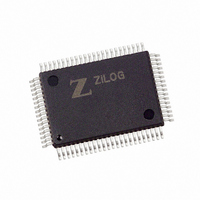Z16F6411FI20SG Zilog, Z16F6411FI20SG Datasheet - Page 189

Z16F6411FI20SG
Manufacturer Part Number
Z16F6411FI20SG
Description
IC ZNEO MCU FLASH 64K 80QFP
Manufacturer
Zilog
Series
Encore!® ZNEOr
Datasheet
1.Z16F2800100ZCOG.pdf
(388 pages)
Specifications of Z16F6411FI20SG
Core Processor
ZNEO
Core Size
16-Bit
Speed
20MHz
Connectivity
EBI/EMI, I²C, IrDA, LIN, SPI, UART/USART
Peripherals
Brown-out Detect/Reset, DMA, POR, PWM, WDT
Number Of I /o
60
Program Memory Size
64KB (64K x 8)
Program Memory Type
FLASH
Ram Size
4K x 8
Voltage - Supply (vcc/vdd)
2.7 V ~ 3.6 V
Data Converters
A/D 12x10b
Oscillator Type
Internal
Operating Temperature
0°C ~ 70°C
Package / Case
80-BQFP
Processor Series
Z16F6x
Core
Zneo
Data Bus Width
16 bit
Data Ram Size
4 B
Interface Type
ESPI, I2C, UART
Maximum Clock Frequency
20 MHz
Number Of Programmable I/os
60
Number Of Timers
4
Operating Supply Voltage
2.7 V to 3.6 V
Maximum Operating Temperature
+ 70 C
Mounting Style
SMD/SMT
Development Tools By Supplier
Z16F2800100ZCOG
Minimum Operating Temperature
0 C
On-chip Adc
10 bit, 12 Channel
For Use With
770-1003 - ISP 4PORT FOR ZILOG ZNEO MCU269-4537 - DEV KIT FOR Z16F ZNEO
Lead Free Status / RoHS Status
Lead free / RoHS Compliant
Eeprom Size
-
Lead Free Status / Rohs Status
Details
Other names
269-4571
Available stocks
Company
Part Number
Manufacturer
Quantity
Price
Company:
Part Number:
Z16F6411FI20SG
Manufacturer:
LT
Quantity:
121
- Current page: 189 of 388
- Download datasheet (22Mb)
PS022008-0810
Baud Rate
IR_RXD
UART’s
Clock
RXD
Caution:
Receiving IrDA Data
8-clock
delay
Start Bit = 0
Data received from the infrared transceiver via the IR_RXD signal through the RXD pin is
decoded by the Infrared Endec and passed to the UART. The UART’s baud rate clock is
used by the Infrared Endec to generate the demodulated signal (RXD) that drives the
UART. Each UART/Infrared data bit is 16-clocks wide.
When the Infrared Endec is enabled, the UART’s RXD signal is internal to the ZNEO
Z16F Series products when the IR_RXD signal is received through the RXD pin.
The system clock frequency must be at least 1.0 MHz to ensure proper reception of
the 1.6
Endec Receiver Synchronization
The IrDA receiver uses a local baud rate clock counter (0 to 15 clock periods) to generate
an input stream for the UART and to create a sampling window for detection of incoming
pulses. The generated UART input (UART RXD) is delayed by 8 baud rate clock periods
with respect to the incoming IrDA data stream. When a falling edge in the input data
stream is detected, the Endec counter is reset. When the count reaches a value of 8, the
UART RXD value is updated to reflect the value of the decoded data.
When the count reaches 12 baud clock periods, the sampling window for the next
incoming pulse opens. The window remains open until the count again reaches 8 (or in
other words 24 baud clock periods since the previous pulse was detected). This gives the
Endec a sampling window of minus 4 baudrate clocks to plus 8 baudrate clocks around the
expected time of an incoming pulse. If an incoming pulse is detected inside this window,
16-clock
min. 1.6 s
period
pulse
Start Bit = 0
s minimum width pulses allowed by the IrDA standard.
16-clock
period
Data Bit 0 = 1
Data Bit 0 = 1
Figure 33. Infrared Data Reception
P R E L I M I N A R Y
16-clock
period
Data Bit 1 = 0
Data Bit 1 = 0
16-clock
period
Data Bit 2 = 1
Figure 33
Data Bit 2 = 1
16-clock
period
Infrared Encoder/Decoder
Product Specification
displays data reception.
ZNEO
Data Bit 3 = 1
Z16F Series
Data Bit 3 =
173
Related parts for Z16F6411FI20SG
Image
Part Number
Description
Manufacturer
Datasheet
Request
R

Part Number:
Description:
Communication Controllers, ZILOG INTELLIGENT PERIPHERAL CONTROLLER (ZIP)
Manufacturer:
Zilog, Inc.
Datasheet:

Part Number:
Description:
KIT DEV FOR Z8 ENCORE 16K TO 64K
Manufacturer:
Zilog
Datasheet:

Part Number:
Description:
KIT DEV Z8 ENCORE XP 28-PIN
Manufacturer:
Zilog
Datasheet:

Part Number:
Description:
DEV KIT FOR Z8 ENCORE 8K/4K
Manufacturer:
Zilog
Datasheet:

Part Number:
Description:
KIT DEV Z8 ENCORE XP 28-PIN
Manufacturer:
Zilog
Datasheet:

Part Number:
Description:
DEV KIT FOR Z8 ENCORE 4K TO 8K
Manufacturer:
Zilog
Datasheet:

Part Number:
Description:
CMOS Z8 microcontroller. ROM 16 Kbytes, RAM 256 bytes, speed 16 MHz, 32 lines I/O, 3.0V to 5.5V
Manufacturer:
Zilog, Inc.
Datasheet:

Part Number:
Description:
Low-cost microcontroller. 512 bytes ROM, 61 bytes RAM, 8 MHz
Manufacturer:
Zilog, Inc.
Datasheet:

Part Number:
Description:
Z8 4K OTP Microcontroller
Manufacturer:
Zilog, Inc.
Datasheet:

Part Number:
Description:
CMOS SUPER8 ROMLESS MCU
Manufacturer:
Zilog, Inc.
Datasheet:

Part Number:
Description:
SL1866 CMOSZ8 OTP Microcontroller
Manufacturer:
Zilog, Inc.
Datasheet:

Part Number:
Description:
SL1866 CMOSZ8 OTP Microcontroller
Manufacturer:
Zilog, Inc.
Datasheet:

Part Number:
Description:
OTP (KB) = 1, RAM = 125, Speed = 12, I/O = 14, 8-bit Timers = 2, Comm Interfaces Other Features = Por, LV Protect, Voltage = 4.5-5.5V
Manufacturer:
Zilog, Inc.
Datasheet:

Part Number:
Description:
Manufacturer:
Zilog, Inc.
Datasheet:











